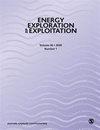A spatial perspective on renewable energy optimization: Case study of southern Tunisia Using GIS and multicriteria decision making
IF 1.6
4区 工程技术
Q4 ENERGY & FUELS
引用次数: 0
Abstract
Renewable energy systems have emerged as a viable option to mitigate the environmental impacts of traditional fossil fuels. However, the intermittent nature of these renewables, such as solar and wind, makes it challenging to ensure a stable energy supply using only one type. Therefore, combining more than a single technology offers significant advantages in addressing the limitations associated with each individual system. Nevertheless, developing these systems requires substantial financial investments, making it crucial to identify the most suitable locations prior to installing them. In this article, the prime objective was to propose a preliminary evaluation of land suitability for constructing solar and wind hybrid facilities (PV–wind, PV–CSP, and CS–wind) in Tataouine, southern Tunisia. To this end, a GIS-based MCDA methodology was developed based on an extensive literature review and experts’ feedback while considering climate, topography, accessibility, and environmental factors. The results obtained revealed that the optimal area for a CSP–PV hybrid system is about 793 km 2 , indicating that this combination has the highest potential in terms of available resources and compatibility. On the other hand, well-suited locations for hosting CSP–wind and PV–wind systems covered areas of 412 and 333 km 2 , respectively. Such specific locations are capable of generating an annual technical potential of 316.169, 91.252, and 62.970 TWh for CSP–PV, CSP–wind, and PV–wind, respectively. Interestingly, comprising almost all of the most appropriate sites, Remada and Dhiba stand as the ideal locations for accommodating such hybrid systems. Considering this outcome, Tataouine can position itself as a model for renewable energy adoption in Tunisia. Therefore, it is imperative for policymakers, investors, and local communities to collaborate and embrace these hybrid systems to capitalize on this immense potential and pave the way for a greener and more prosperous future.可再生能源优化的空间视角:突尼斯南部使用GIS和多标准决策的案例研究
可再生能源系统已成为减轻传统化石燃料对环境影响的可行选择。然而,这些可再生能源(如太阳能和风能)的间歇性使得仅使用一种能源来确保稳定的能源供应具有挑战性。因此,结合多种技术在解决与每个单独系统相关的限制方面具有显著的优势。然而,开发这些系统需要大量的财务投资,因此在安装之前确定最合适的位置至关重要。在本文中,主要目标是对突尼斯南部Tataouine建设太阳能和风能混合设施(PV-wind、PV-CSP和CS-wind)的土地适宜性进行初步评估。为此,在广泛的文献回顾和专家反馈的基础上,同时考虑了气候、地形、可达性和环境因素,开发了基于gis的MCDA方法。结果表明,CSP-PV混合系统的最佳面积约为793 km2,表明该组合在可用资源和兼容性方面具有最大的潜力。另一方面,适合安装CSP-wind和PV-wind系统的地点面积分别为412平方公里和333平方公里。这些特定地点的CSP-PV、CSP-wind和PV-wind的年技术潜力分别为316.169、91.252和62.970太瓦时。有趣的是,包括几乎所有最合适的地点,Remada和Dhiba是容纳这种混合系统的理想地点。考虑到这一结果,Tataouine可以将自己定位为突尼斯采用可再生能源的典范。因此,政策制定者、投资者和当地社区必须合作并接受这些混合动力系统,以充分利用这一巨大潜力,为更绿色、更繁荣的未来铺平道路。
本文章由计算机程序翻译,如有差异,请以英文原文为准。
求助全文
约1分钟内获得全文
求助全文
来源期刊

Energy Exploration & Exploitation
工程技术-能源与燃料
CiteScore
5.40
自引率
3.70%
发文量
78
审稿时长
3.9 months
期刊介绍:
Energy Exploration & Exploitation is a peer-reviewed, open access journal that provides up-to-date, informative reviews and original articles on important issues in the exploration, exploitation, use and economics of the world’s energy resources.
 求助内容:
求助内容: 应助结果提醒方式:
应助结果提醒方式:


